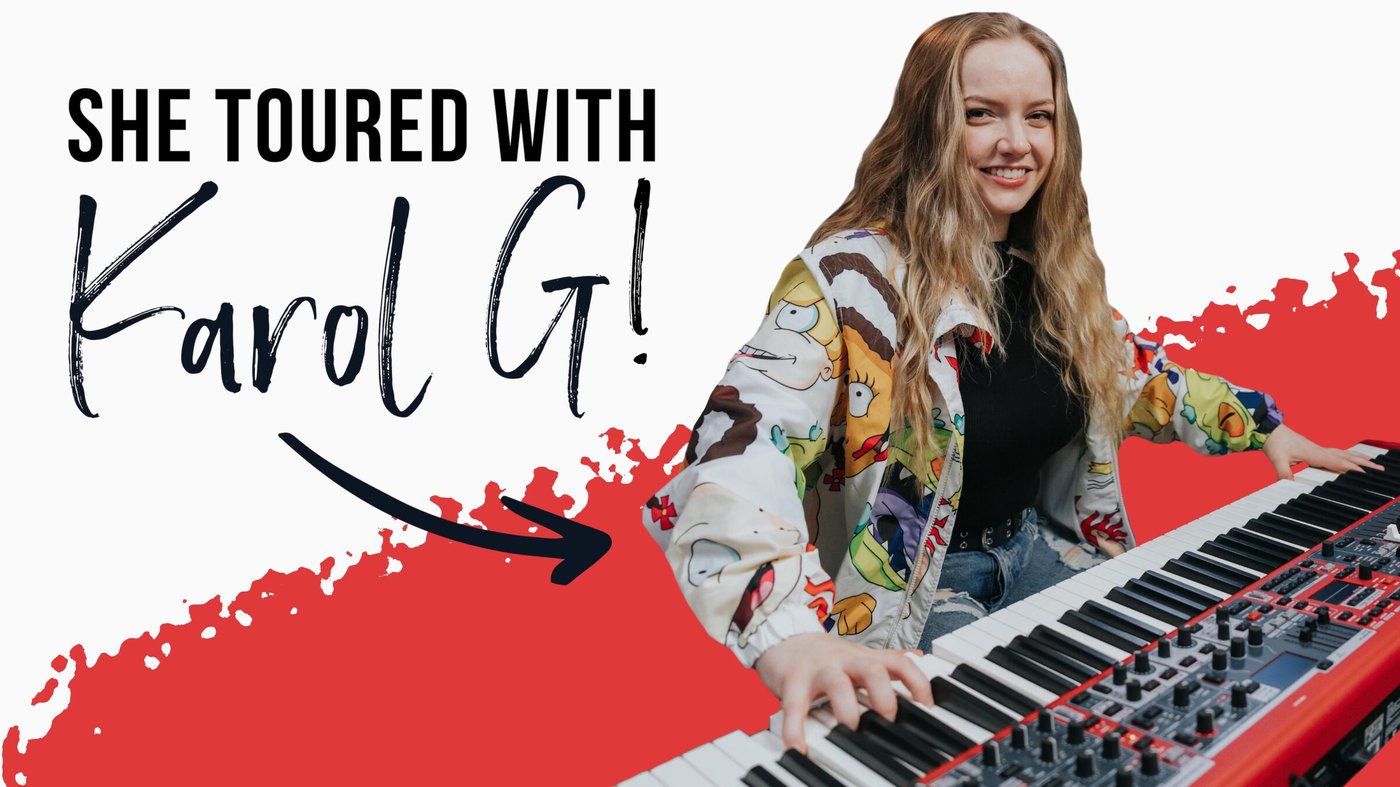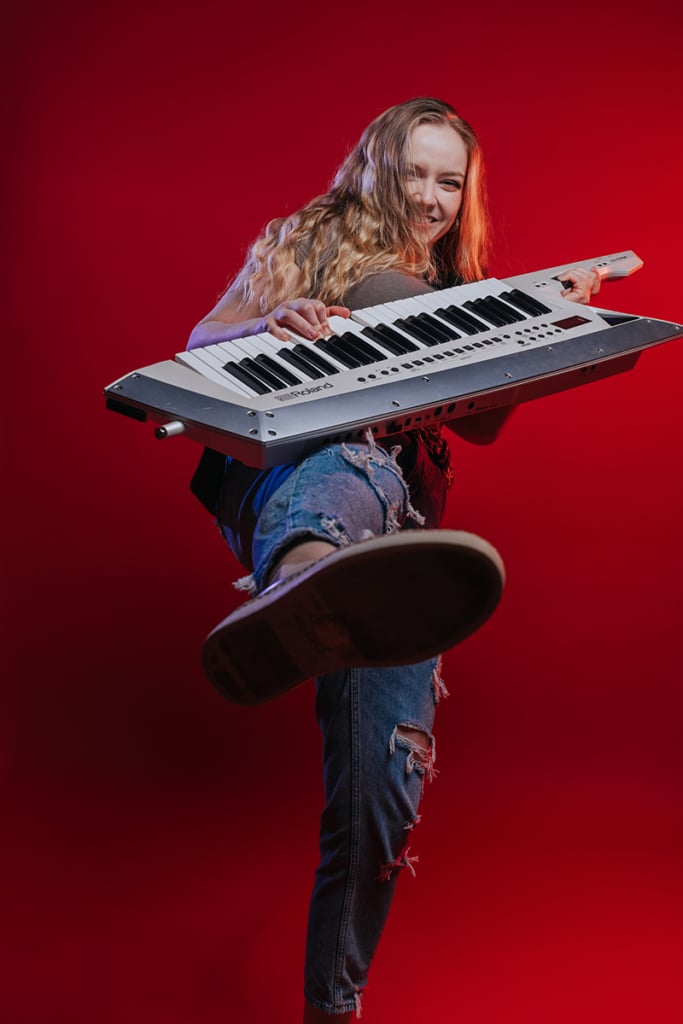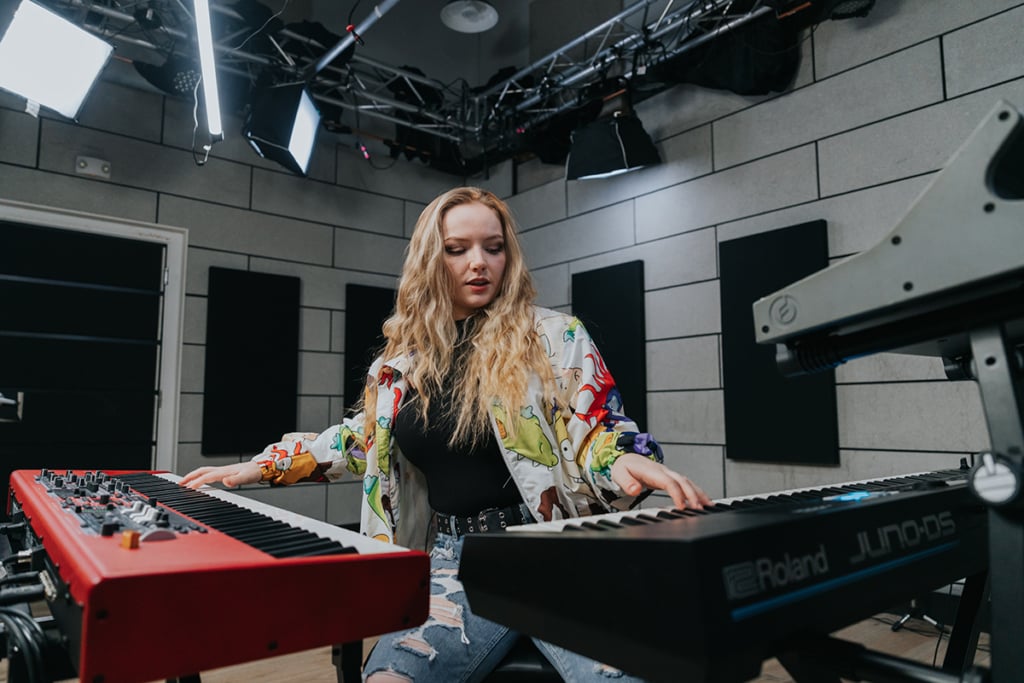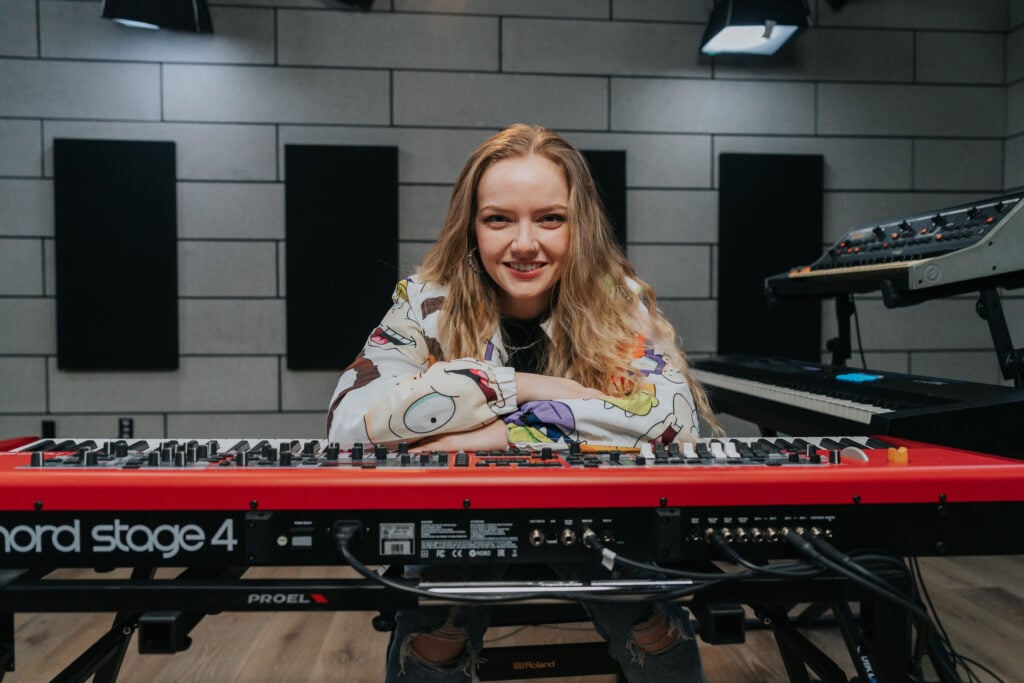
So you want to be a professional musician when you grow up. You’ve done lessons, you’ve practiced, maybe you’ve even applied to Berklee! But how do you actually break into the music industry in the social media age of the 2020s? And what skills do you need to thrive in the real world music industry?
We recently chatted with Jemma Heigis, an American keyboardist based in Peru who toured with GRAMMY-winning superstar Karol G. You’ll learn first-hand what it takes to land gigs and play stadiums!
(The following interview has been edited for length and clarity.)
Table of Contents:
Get exclusive interviews, fascinating articles, and inspiring lessons delivered straight to your inbox.
My name is Jemma and I’m a keyboard player, producer, and composer. Right now, I’m working on my own music. But in the past year, I went on tour with Karol G! She’s a reggaeton superstar and we did the mainstage of Coachella, Tiny Desk, and also SNL.
I started playing piano at three years old. I always knew that music was the thing that I was going to pursue because nothing else interested me quite as much. So I practiced a lot and I was always composing my own music.
Before I moved to Peru, I was living in Minnesota and studying film composition because I wanted to be a film composer. I did an audition for McNally Smith (it’s kind of like Berklee—I didn’t try out for Berklee because it was financially out of the question.) I got a scholarship and that’s where I met my husband. We’re both keyboard players and we’ve been working together ever since.
I posted a video with my friend, Lucia Sarmiento (she’s a saxophone player) and it went viral. I was on a cruise ship when it happened and I didn’t have internet access, so I didn’t notice until after I came back that it had gone viral!
I noticed there could be a way to advertise my own stuff and make a name for myself. So I started posting pretty regularly on social media. Just covers and trying to play impressively and stuff.
I ended up not doing film composition at all because I felt a little constrained as an artist. I couldn’t compose what I wanted to compose—I had to compose what was best for the scene. A lot of modern film music is really minimalistic too, not the grandiose sort of stuff I would want to compose. But I guess that’s work! (Where not everything is what you want to do.)
I ended up studying more piano. And I think Instagram forced me to practice way more… Posting on a daily schedule was the biggest thing that helped me get better at my instrument. Which is funny, but it’s true.
Well, I get paid to do posts for brands. That’s what you would consider an influencer, right? It sounds almost like a dirty word…
It started out as kind of like a resume—and that’s how it ended up. And I’m glad I got in when I did because it’s hard to grow. I started maybe six years ago or something, and now it’s become for musicians. It is your resume. Like, my degree means nothing! …I mean, I have a bachelor’s degree and I’m glad I got it because it taught me so much and I’ve met a lot of great people.
If being an influencer is what it takes to be a successful musician then sure, I’ll consider it!
I would say that it’s consistency—just continuing to post all the time.
I have a Patreon—that’s where I’m getting most of my income. I do lessons and for every post, I do a transcription of it. And I extend the backing tracks so people can take the exercise they’ve learned and improvise over it. I’ll give them the best scales to use and stuff like that. So, I’m trying to gravitate more towards the sort of videos you guys do.
I think being a music influencer is good because people tend to know who you are—people that you wouldn’t expect. The fact that I posted so frequently made me appear in people’s algorithms. So, post regularly even if you’re a nobody! Chances are one of your videos will do well and that’ll recommend you to people you never would have had access to. Then, those important people might see you, think you are a good fit, and reach out.
The way I got that Karol G gig was like this: Lucia got a huge gig with Pitbull. Now, the music director for Pitbull was the same musical director for Karol G. And Karol G’s keyboard player went to play with Jacob Collier, so there was an opening. (That’s Bryn Bliska, by the way. She’s amazing!)
Anyway, Lucia said that I was a good fit so I got an audition. I had to record three songs and I had to do it as if I was performing. One of the songs was solo piano: it was a grandiose intro while someone might be talking. I also did some vocal and piano stuff to prove that I could also sing—and they picked me!
When I was in Minnesota and posting videos on social media, I was working as a waitress so my income wasn’t even from music. So, I basically went straight to giant stadiums and this huge artist!
I was so surprised…I had heard the name Karol G but I didn’t know how famous she was. Especially where I live now in Peru: everyone knows who she is. I would go through immigration and there would be Karol G playing in the speakers. So it was pretty surreal.
The fact that I had built up a small following—I think I had 10k around that time—helped too. If you’re a musician and you post videos consistently, people have a smorgasbord of things to choose from to say, okay, this girl can do funk; she can play synth; oh, she has a singing video here so maybe she can do background vocals, etc.
I moved to Peru because when we came back from the cruise ship, my husband ran into visa problems entering the States. We were going to get married…but unfortunately that never happened and he got stuck in immigration. So I dropped all my stuff and moved to Peru. His parents were very, very generous. They let me live in their house and we built my social media career from there. His parents even helped me put up lights and they would lend me clothes to help me have more outfits!
We got married in Peru and I learned Spanish in the process. I’ve lived here for five, six years, I think. When I showed up, I just knew stuff you learn in high school. And now I’m fluent!
That was a huge benefit when they were picking who to audition and who they were selecting. The fact that I was American also helped because of being able to perform in the States. But the fact that I spoke Spanish was a big plus because Karol works in Spanish; everybody talks in Spanish in your in-ears.

It was a blessing in disguise that I moved to Peru. I don’t know if the same thing would have happened if I had remained in the States. I could still be a waitress right now!
That’s a good question. Playing for Karol G is not about how many chords you know or how great your music theory or ear is. It’s about sound design. I thought it was going to be a live, acoustic-sounding arrangement or something like that. But it wasn’t at all!
I had never used expensive keyboards before (my Roland Juno DS was probably $400) so I had to learn all these keyboards and it was kind of a shock. Every song had to have its own specific programming. You would have the keyboard split into the flutes on top, a piano over here, a synth bass there…and you would have to know how to program all of that. The pedal might be routed to how much reverb there is on the strings alone, and the mod wheel might be routed to how much delay is on the flutes. It’s like learning a computer, you know?
I had never done so much before. And when you’re in an environment where there’s so much pressure…that’s what teaches you the most.
It’s the same for Spanish: I would say something silly and embarrassing that I would never forget. For sound design, I was on the spot so many times because everybody else in the band would be like, “No, that sound is not it.”
I did the sound design for her latest album. But when I was first brought in, I had to get the other keyboard player on a call and help. She very generously gave me a backup of all of the sounds that she had used and I learned her programming. There was also a musical director and he would tell me, “No, that’s not how she did it; I think she had this over here.”
It was nerve-wracking, I’m not gonna lie! It was two weeks of rehearsals and maybe eight, nine hours per day of rehearsing. But, to answer your question, I would say for a big gig like this you need to know how to program keyboards.
I didn’t. (I learned a lot about working with DAWs like VSTs, Logic, Pro Tools, Ableton.) I knew a little bit about programming keyboards because of the cruise ship that I worked on. But what my $400 keyboard could do was pretty limited.

These keyboards that big-time artists use are mostly Nords. So, learn how to use a Nord! I would rent one or get a used one and just practice. You can practice by listening to songs and trying to replicate them. It’s not just about learning the keyboard; it’s also understanding what is a cut-off, what is an envelope, and how—if I change the attack—will it make it sound more similar to the reference?
It’s a lot of experimenting. I would first use some VSTs and try to emulate sounds. Even GarageBand has some VSTs included with it.
It’s like learning a new instrument. The way you recall patches, it’s all different. Yes, there are similar things like envelopes and filters—and some parameters will be standard on any synth—but each one has its own thing.
The rehearsal time is way more than I would have ever expected. When I was in bands in school, a long rehearsal would be three hours. But in the real world, everybody’s mentality is: we’re here to put on a giant show and we’re going to do whatever it takes to make that happen. And so rehearsals will sometimes go until 2am, 3am… Or they’ll start in the middle of the night. It’s a lot more work than you would think. A lot of standing up, rehearsing the same song 20 times in a row.

And it’s a lot of trying to keep your brain from turning off. Because after you understand sound design, the music is not that difficult. Reggaeton by nature is not super harmonically advanced. So if you lose focus, you start getting worse the more you play! It’s almost like saturation.
But that’s how it works: you have dancers, you have a production team, and the show is tomorrow. So you’re not going to take a break. I would say be prepared to have a very, very long rehearsal.
Another thing would be: there’s no room for improvisation. If you think you have a better voicing, that’s not your job. (That was my experience anyway.) Because the people that listen to Karol G—they know the song so well that having it sound any different would be weird. Also, we have a musical director and he makes the executive decisions of what you’re going to play.
Yeah! That’s a good comparison. Even the mentality of it. It’s not a relaxed environment.
It’s not like a gig with your friends where you’re like, “Alright, you guys want to order a couple of beers? When do you guys want to go? I can stay an extra hour.”
It’s a very structured environment. It’s a big production. It needs to be.
Well, I started by doing vocal pop. I’m a singer, but it wasn’t really my forte (I didn’t feel that comfortable as a frontman).
Through social media, I discovered a niche: people that like video games and jazz. It’s this really cool combination. Adam Neely did a video on the “jazzification” of Nintendo that really resonated with me because he talks about how a lot of today’s video game music will be the “All the Things You Are” of the future. It’s true because a lot of really classic video games are being adapted by big bands. I thought that was really cool and it makes sense why so many people that love Sonic covers also appreciate the sort of fusion that I do.
So, I decided that I wasn’t going to be a singer anymore. I post fusion video game covers, anime stuff, some pop…but for the most part I’ve been doing funk and fusion. One day it occurred to me that I should be making instrumental music because that’s what I listen to: Snarky Puppy, Mark Lettieri, Tribal Tech, Jeff Lorber…
I just released my first instrumental single. It took me a really long time because it took me a while to find a soloist. But I did and I’m so glad that she did it even though she was really busy! Actually, she’s the trumpet player for Karol G right now! Her name is Ella Briceño and she did an amazing trumpet solo. She’s a virtuoso and so I’m super glad I got her on my track and finally released it.
I was supposed to read music because I took so many classical lessons, but I faked it the whole time! (My music teacher, Peggy Andrews: I’m sorry if you’re reading this!). I’m able to read and arrange and when it comes to actually notating it, I’m fine. But my sight reading is terrible!
I’ve always liked ear training and that’s the fastest way for me to learn because it forces me to memorize as well. So whenever I’m learning a song, my first route is ear training. Unless it’s so difficult that I could never get it by ear—then I will sit down and try to read it.
Ear training really helps your skills as a musician. That’s another thing for people that are starting out in music: just learn the songs you like. Sit down and play them as best as you can. And there are tutorials out there that can teach you the best way to voice it. Or fingerings and stuff like that.
But yeah. Whatever you like, sit down and try to play it yourself.
As a Pianote+ Member, you’ll get access to our 10-step Method, song library, and growing community of piano players just like you. Plus: get coached by world-class pianists and learn whenever you want, wherever you want, and whatever you want.
TRY PIANOTE FOR 7 DAYSCharmaine Li is a Vancouver writer who has played piano for over 20 years. She holds an Associate diploma (ARCT) from the Royal Conservatory of Music and loves writing about the ways in which music—and music learning—affects the human experience. Charmaine manages The Note. Learn more about Charmaine here.
/marketing/pianote/lead-gen/getting-started/coach.webp)
/marketing/pianote/lead-gen/getting-started/logo.webp)
By signing up you’ll also receive our ongoing free lessons and special offers. Don’t worry, we value your privacy and you can unsubscribe at any time.
We use cookies for traffic data and advertising. Cookie Policy »
/marketing/pianote/lead-gen/chords-progressions-digital-book/chord-progressions-exit-m.webp)
Want to play the most popular songs on piano?
Grab the Little Book of Chord Progressions to learn the most popular chord progressions used in modern music.
No credit card. No spam.
Just awesome chords to get you playing.
Don’t worry, we value your privacy
and you can unsubscribe at any time.